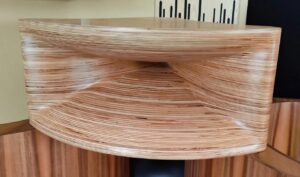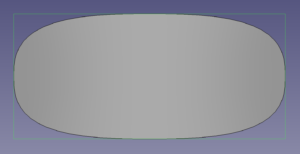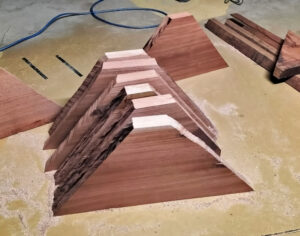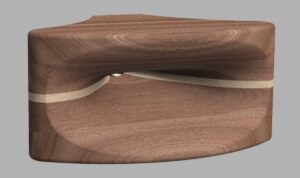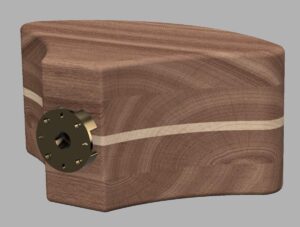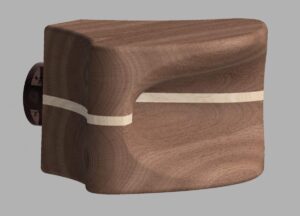When I was looking for options to produce my first prototype, I contacted Lautsprechermanufaktur Heyder, among others. But somehow it didn’t lead to any concrete plans. Jens Heyder has long been known for his product range from wooden horns to complete loudspeakers. The information available on the products he produces conveys high quality and excellent craftsmanship. Jens also seems to have a fairly decent range of machinery, including CNC. Under these conditions, even complicated or larger horns should be possible to realize. I am therefore more than pleased to announce that Lens Heyder will be offering my William Neile horns according to his own highest quality standards, manufactured from solid wood.
The initial product range will be the William Neile “super elliptical” ALO horns. The corresponding horns have an additional abbreviation “SE” in their name. DonVK already made two pairs for himself based on a special optimization for one of his 2-inch drivers, applying his unique workflow by adding a round-over to the inner profile. The first horn was a PoC (WN425SE ALO). The second larger horn,WN270SE ALO, is part of his current listening setup:
So far as I am aware, he is still listening to this setup with great pleasure.
When we discussed what size / cut-off to present first, the decision was for the WN300SE ALO horn. A freestanding implementation like DonVK’s elliptical horns may be an option for the future. My personal preference is still what I call block shape (two halves each milled from a solid block of wood) because this shape is looking fantastic, and it can easily be placed on top of a bass cabinet similar to my WN300ALO horn:
With respect to the super ellipse, a new parameter appears, called Lamé exponent. Practically, only values greater than 2 make sense. With an exponent of 2 an ideal ellipse is the result. Making the exponent larger than 2 a transition towards a quadratic shape occurs. Extensive examples can be found for furniture and architecture as use case for a super elliptical shape/blueprint. For my “WNxxxSE” horns, I decided to use a “magic” number of e = 2.7183 (I refer to Gerald Robinson here). Many may recognize that this is the exponential function. I don’t want the specific number to be viewed as overestimated, but for me the choice is in the golden middle between elliptical and squared shape and, especially in the simulations, presented itself with excellent results.
In my opinion, these are excellent BEM results. Although, it should be emphasized that the model need to be kept with a reasonable number of elements, and especially an additional round-over in the simulations would greatly improve the vertical result and eliminate the spurs in the outer regions. So the behavior of the real horn will be much better than shown here based on the simplified model. The parameters for the calculator were optimized to provide the best compromise between loading and directivity control. Another major design goal was to avoid any abrupt profile changes and to avoid any waist-banding effects. This cannot be reached with a simple horn formula/function. My calculator is quite complex, dealing with several different sections/function internally. But the real art is that this is not visible for the final profile shape, as all transitions are kept totally smooth. I am very satisfied with the overall results and could convince Jens to offer this type of horns horn as authorized prototype.
It should be noted that this WN300SE ALO horn has an 1.5″ throat entry. I have some very nice 1.5″ exit drivers and these will be a perfect fit. I don’t like to use an adapter with a compression flare from 1.5″ to 1.4″ because this would mean a change in the flare rate after the adapter. On the opposite, an adapter from 1.4″ to 1.5″ can be made with exactly the same flare rate as the horn, so with an appropriate adapter 1.4″ drivers will work with this horn.
For the first showpiece, we decided on a special mahogany wood that had been stored for 12 years and therefore had enough time to dry and become internally “silent”. Here are some impressions of the preparation of the raw material for the CNC process:
Since the raw material always has certain tolerances, it can be a challenge to achieve the correct dimensions of the CAD model (in this case the vertical height). We therefore decided to add a compensating layer with a different wood in the middle of the horn. Internally, we talk about it as racing stripe. The suggestion came from Jens because he used this kind of construction with a distinct contrast for another project.
To give you an idea of what to expect, Jens sent me some renderings based on my sketches and suggestions. The horns will be made according to this blueprint:
For later variants based on multiplex wood, such a racing stripe may not be necessary, but to be honest I really like the look.
Quite a long time we discussed how to realize the adapter section and finally ended up with the metal adapter shown which is detachable. As this horn has a 1.5in entry, either an additional adapter could be used or another adapter in one piece which has the additional 1.5in to 1.4in part included with the same flare rate as the horn (as explained above).
Stay tuned how this project is going on and maybe take a look at Jens Heyders homepage in the meantime:
https://www.lautsprechermanufaktur-heyder.de/


